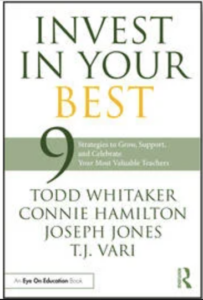Invest in Your Best: 9 Strategies to Grow, Support, and Celebrate Your Most Valuable Teachers
By Todd Whitaker, Connie Hamilton, Joseph Jones, and T.J. Vari
(Routledge/Eye On Education, 2024 – Learn more)
Reviewed by Matt Renwick
 One of my favorite parts of being a principal was hiring new teachers.
One of my favorite parts of being a principal was hiring new teachers.
Beyond recruiting, interviewing, and offering the position, I saw the process of hiring a new teacher to be the easiest and most effective way to improve schoolwide instruction.
Assuming I did my job and brought in a highly effective instructor, there were so many benefits that this person brought to the organization.
- They raised the expectations for performance for the rest of the faculty.
- I didn’t have to provide much if any corrective feedback. In fact, I learned more from them than they did from me!
- Great teachers attract other great teachers. The word gets out that your school hires the best, and that piques the interest of educators of similar competence.
Once you get excellent teachers into the building, how do you retain them?
This is the challenge leaders face in the schools I serve now as a systems coach. It’s a common challenge across the country. Low respect and pay, unreasonable mandates, and dealing with difficult parents/guardians can wear out the most committed in our profession.
 That’s why Invest in Your Best: 9 Strategies to Grow, Support, and Celebrate Your Most Valuable Teachers feels so timely. This book offers practical and high-impact ideas for keeping your best instructors satisfied and motivated to do what they do best.
That’s why Invest in Your Best: 9 Strategies to Grow, Support, and Celebrate Your Most Valuable Teachers feels so timely. This book offers practical and high-impact ideas for keeping your best instructors satisfied and motivated to do what they do best.
Authors Todd Whitaker, Connie Hamilton, Joseph Jones, and T.J. Vari, are all experienced administrators at the building and district level. This collaboration provides the reader with a wide perspective of ideas for a building leader to choose from as they seek to support their most effective teachers.
Here are a few of my favorite strategies from the book.
1. Identify your best.
The authors offer clear criteria for recognizing who your best teachers are in the building.
- They often stand out to everyone as the most positive people on the staff.
- They are the strongest contributors to new, quality initiatives and programs at your school that will have a positive impact on students and families.
- They have a growth mindset.
- They get results.
Whitaker and colleagues believe that 3-10% of your staff fall into this “superstar” category. This information can be helpful as you begin to identify in whom you want to invest more time and support.
2. Talk to your students.
If you want to discover who the best teachers are in your school and why they are the best, just ask your students. They are both very perceptive and honest. Currently living with two high school students, I can attest to the accuracy in their evaluations. It makes sense; they are direct recipients of the level of quality in instruction.
What’s important here is learning why these teachers are the best. You can gain this information by conducting interviews and administering surveys. “What do your best teachers do differently than the other teachers?” is a good question to ask. The authors recommend avoiding “favorite teachers,” as this can give you different responses.
3. Make decisions based on your best teachers.
Sometimes principals will make decisions that are meant for a few teachers but affect the entire faculty. A prime example is expecting weekly lesson plans to be submitted to the office. This is too often done to ensure a small minority of the faculty do the minimal required of their position. But it puts an undue burden on your best teachers who now have an added responsibility to their week that isn’t necessary.
As the authors note, “don’t use policies to mask an unwillingness to address poor performing teachers. This type of leadership…leads to low morale, decreased productivity, poor mental health, and increased turnover” (p. 23).
Instead, make decisions based on your best teachers. Going back to the previous example, communicate clear expectations for what you expect in teachers’ lesson plans when you make informal classroom visits. Use your best teachers’ plan as the benchmark for what you want to see. This is no added work for your superstars, and it raises the stakes for everyone else. This supports your best teachers and student learning at the same time.
4. Communicate the impact great instruction has on student learning.
I learned in my 16 years as a principal that most teachers in a school demonstrate highly effective instruction in at least part of their practice. When I observed excellence in action, I was diligent about documenting it in words and images, and then sharing what I discovered in weekly staff newsletters and on social media.
While it was easy to find aspects of our superstars’ practice to celebrate and showcase, I was careful to recognize each teacher publicly. This is important. We don’t want to single out our best teachers for praise; they can be viewed as the principal’s pets. And yet, as the authors note, we must let the public know about the impact of our best teachers on students and the community if we are to change the narrative about education.
“When it comes to schools, people want to know the impact. Impact sells because it’s emotional, interesting, and newsworthy. It’s easy to feature the athletic teams, the band, the school plays, etc. But, lifting the brand of the school requires stories about our best people and the work they’re doing that impacts the community” (p. 45).
If I didn’t have a word count limit here, I’d share more good ideas from Invest in Your Best. It’s full of useful and practical insights that any school leader can “take to the bank” and trust that their application will lead to greater retention of their most effective teachers.
Matt Renwick is a systems coach for CESA #3, an state-supported education service agency in Southwestern Wisconsin. During his 20-year career in education, he has served as a principal in two Wisconsin elementary schools and as a middle grades vice principal, teacher and athletic coach.
Matt is the author of Digital Portfolios in the Classroom: Showcasing and Assessing Student Work (ASCD, 2017) and Leading Like a C.O.A.C.H.: Five Strategies for Supporting Teaching and Learning (Corwin, 2022). Available now at his Read by Example substack is Ten Actions for Supporting Teaching and Learning Playbook. Subscribe to his substack and follow him on Bluesky @readbyexample.bsky.social. Read all his MiddleWeb articles here.


